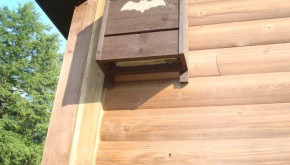
Have you seen a box nailed to the side of a building, or on a post in a field, and wondered what it was for? Bats are friends from the forest. Little brown bats, big brown bats, and numerous other species flit about the evening sky, eating insects and playing a role in the forest ecosystem.
Many bat populations are in decline. In the forest, bats with large trees and made their homes under the thick, flaky bark. As larger, older forests disappear from the landscape, bats are left without their ancestral homes. Bat populations are being further decimated by diseases such as the white-nose syndrome.
Homemade bat boxes can help provide a home for bats. This article provides some tips for attracting big brown bats.
- Big brown bats tend to prefer bat boxes mounted on buildings. Boxes mounted on chimneys are very successful.
- Mounting height can range from 6 to 12 feet. Less height is needed if the area is mowed and the ground slopes downward away from the bat box, giving the bat room to gain momentum as it plunges out of its house.
- Bats will NOT use bat houses mounted on trees!
- Big brown bats need lots of ventilation, especially during hot, humid weather. 7/8" spacers between the bat box and wall create an extra well-ventilated crevice.
- Eastern-facing boxes are preferred for early morning warming from the sun. South- and west-facing boxes are also used by big brown bats.
- Big brown bats prefer temperatures between 80 and 95 degrees. Big brown bats are active from early March until late November and will hibernate in attics or walls where the temperature remains between 40 and 50 degrees.
- Big brown bats change roosts frequently, as much as every 3 to 5 days.
- Big brown bats fly around tree top level with a flight pattern similar to a bird and have a wingspan of 12-14" wide.
- Big brown bat colonies are much smaller than little brown bat colonies, usually under 100 bats.
- Big brown bats give birth to one, sometimes two pups per year. However, they have a higher mortality rate, and it is common for big brown bat pups to fall from boxes, especially when crowded.
- Big brown bats are not as much affected by white nose syndrome as other species are. Big brown bats hibernate in drier areas where the moisture-loving fungus is not as prevalent.
References: Tuttle, Merlin D., and Donna L. Hensley. The Bat House Builder's Handbook. Austin, TX: Bat Conservation International, 1993. Print.
For more information on bat box building, please visit this helpful page by Rutgers Extension and this presentation on bat house plans and tips.
Special thanks to Terry Lobdell for providing the information and photos for this article!

